Many types of herons exist worldwide; some are common, some almost endangered, and some are so stealthy and secretive we know very little about them.
Herons are predominantly aquatic birds with a broad diet, by all accounts.
There are about sixty different types of herons worldwide, divided into three main groups: herons, egrets, and bitterns. They vary in size, plumage, hunting tactics, and so much more.
For instance, did you know that some herons are pirates? Then there’s the black heron that turns itself into an umbrella shape to trick fish.
And finally, some types of herons were almost wiped out because their plumes were used in the fashion industry and were worth more than gold.

What Is A Heron?
Herons are long-legged, long-necked wading birds in the family Ardeidae and order Pelecaniformes.
A characteristic of herons is that their necks are bent in an S-shape, allowing them to strike at their prey from a standstill.
As these types of birds wade through coastal or freshwater areas, herons dine on fish, frogs, crustaceans, small mammals, and small birds.
Herons tend to have a large wingspan, long and pointy bills, and powder downs. Powder downs are feathers that aid a heron’s preening.
These feathers continuously disintegrate into a powdery form, absorbing and removing slime, scum, and unwanted oils from their plumage.
Some types of herons fly with their necks bent and feet loosely trailing. This is unlike most birds that fly with their necks outstretched and legs tucked in.
Finally, some types of herons are called egrets or bitterns. Egrets are always smaller than herons, have more white plumage, and are more aggressive than herons.
Bitterns, on the other hand, belong to a different genus in the Ardeidae family and have slight differences in appearance.
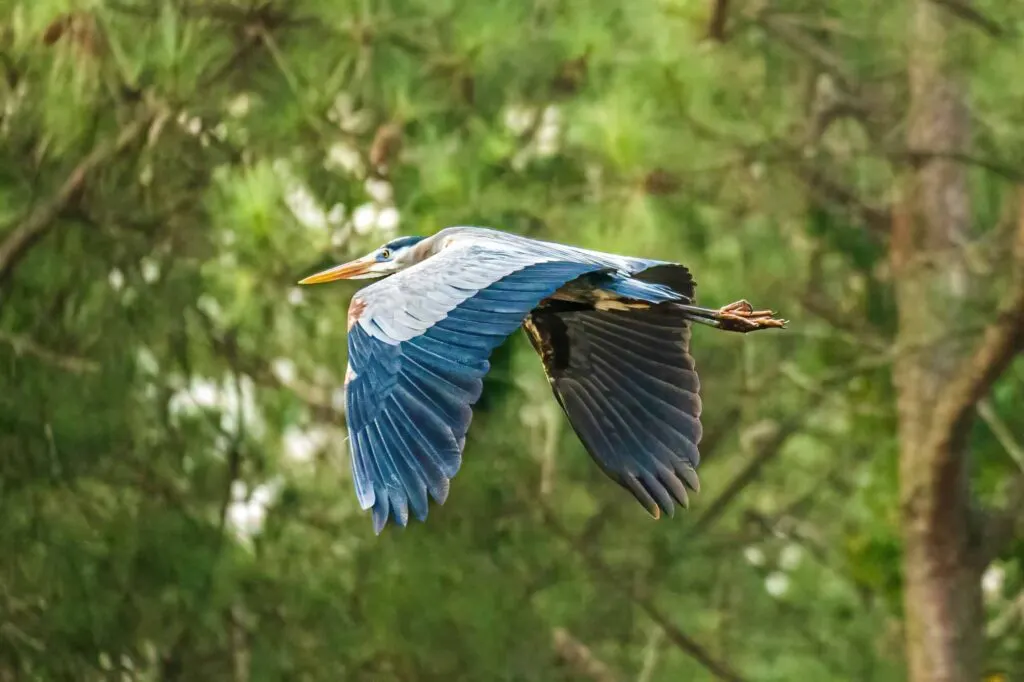
Heron Types
The different types of herons are categorized into three groups: daytime herons or nighttime herons and egrets, bitterns, tiger herons, and the boatbill.
Daytime herons and egrets are diurnal (active during the day and resting at night).
In contrast, nighttime herons are nocturnal (active during dusk or nighttime and resting during the day).
Interestingly, daytime herons have longer necks than nighttime herons, while nighttime herons have thicker bills and shorter legs.
Bitterns, as mentioned, belong to a different genus within the Ardeidae family, namely Ixobrychus.
These water birds are more secretive than herons and egrets, as well as stockier – reaching between 12 to 16 inches in height.
Additionally, their necks are shorter, and they only have ten tail feathers (rectrices), unlike other Ardeidae members, which have twelve.
Finally, tiger herons belong to the subfamily of herons called Tigriornithinae. Tiger herons used to be called tiger bitterns because of their build and behavioral traits.
There are six species of tiger herons, all considered the most primitive herons in existence.
18 Interesting Types of Herons
Here are 18 of the most fascinating types of herons in the world!
1. Gray Heron

The gray heron (Ardea cinerea) is a larger heron native to parts of Europe, Asia, and Africa. It has gray plumage with a lighter neck.
Adult gray herons have white crowns with a striking black supercilium and thin crest. They also have a black stripe on their shoulders.
Gray herons are relatively tall, measuring up to 3.3 feet and weighing around 4.4 pounds.
Most gray herons are residents, though those in northern areas migrate south during winter.
They can be found hunting in both coastal and freshwater areas and even in open fields after harvesting.
Gray herons are usually seen alone, but occasionally they can be spotted in small groups.
Their diet varies, eating fish, eels, ducklings, rodents, and amphibians. They are most active in the early morning and just before sunset.
Gray herons are monogamous and nest in heronries. Their nests are large and flat, usually in tall trees near wetland areas.
2. Western Reef Heron
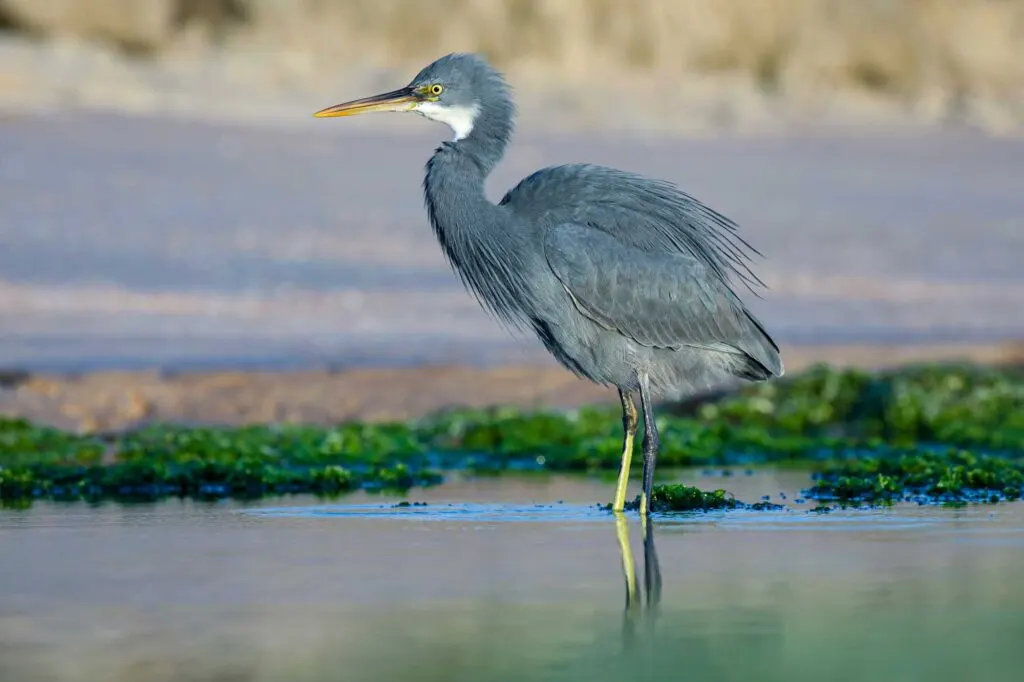
The western reef heron (Egretta gularis) is a medium-sized heron, also called a western reef egret.
They have slate-gray plumage with a white neck, yellow bill, and yellow feet. Western reef herons have an all-white morph variant with gray bills and legs. They are about 1.5 pounds and 2 feet in length.
Western reef herons are found along the tropical west coast of Africa, on the shores of the Red Sea, the Persian Gulf, and in India.
Their diet consists mainly of mudskippers, fish, mollusks, and crustaceans.
Western reef herons nest in colonies of their own species but also sometimes with other types of herons and smaller egrets.
Their nests are platforms made of sticks in shrubs and bushes. Both parents will look after their clutch of eggs and will provide shade for their chicks during the hotter times of the day.
Did you know? Of all the collective nouns for animals, the names for groups of birds are the most fascinating ones. A group of herons is called a siege or a station of herons!
3. Reddish Egret

Reddish egrets (Egretta rufescens) are larger than snowy egrets and are about the same height as a goose. Two coloration morphs exist for reddish egrets.
The first, after which it is named, has slate-gray wings and a russet-colored neck and head.
The other morph has completely white plumage. Both morphs have two-tone bills; they are pink at the base and have black tips.
Like the snowy and great egret, reddish egrets fell victim to the plume trade in the United States.
They can look shabby at times, with their neck and head feathers extended. They are between 27 and 31 inches long and weigh between 24 and 30 ounces.
Reddish egrets are resident breeders in the following areas: Central America, the Bahamas, the Gulf Coast, the Caribbean, and Mexico.
It is commonly found in mudflats and eats mostly fish. They use interesting foraging methods, startling fish or using their wings as umbrellas to attract fish into the shade before catching them.
4. Whistling Heron
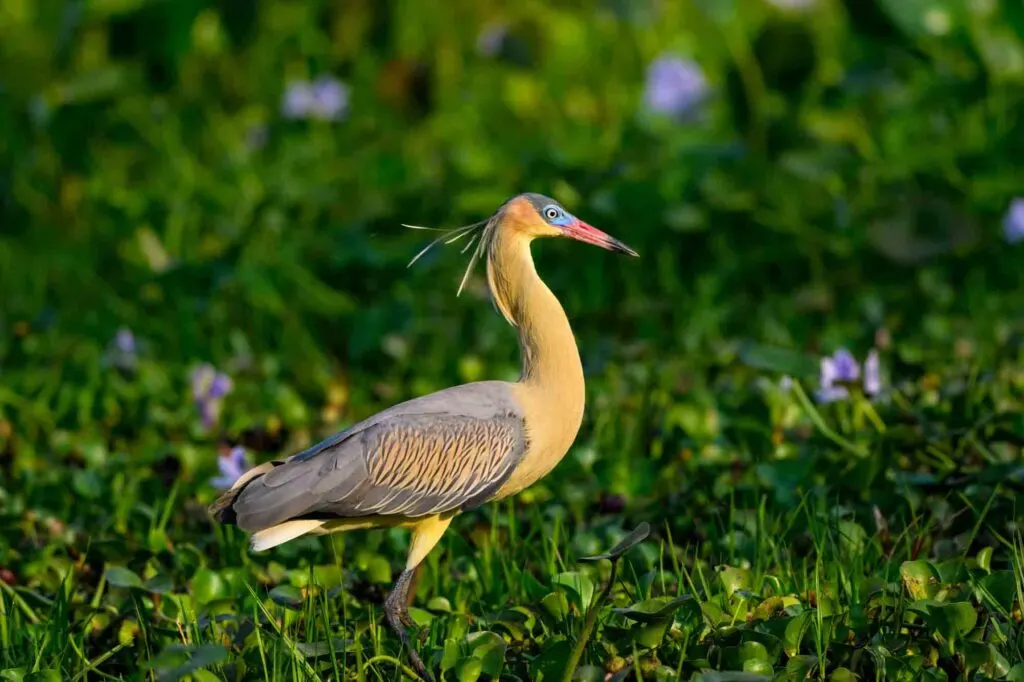
The whistling heron (Syrigma sibilatrix) is a distinctive and territorial bird native to South America. It got its name from its distinctive whistling calls.
Whistling herons are about 25 inches in length and weigh around 19 ounces. There are two subspecies of whistling herons, namely the northern S. s. fostersmithi and southern S. s. sibilatrix.
In terms of its coloration, the whistling heron is a very colorful bird compared to other types of herons. It’s mostly gray, but its chest is almost golden.
Whistling herons have dark crowns and crests with 2-inch plumes and a large bare blue patch around their eyes. The wings are cinnamon-colored, their bills pink and blue or violet, and their long legs are black.
These heron species are considered one of the least aquatic herons. They are found in seasonally flooded savannas and drier grasslands.
Whistling herons eat small animals and insects, notably dragonflies. When they see their prey, they keep their heads still, but their necks seem to dance.
5. Green Heron
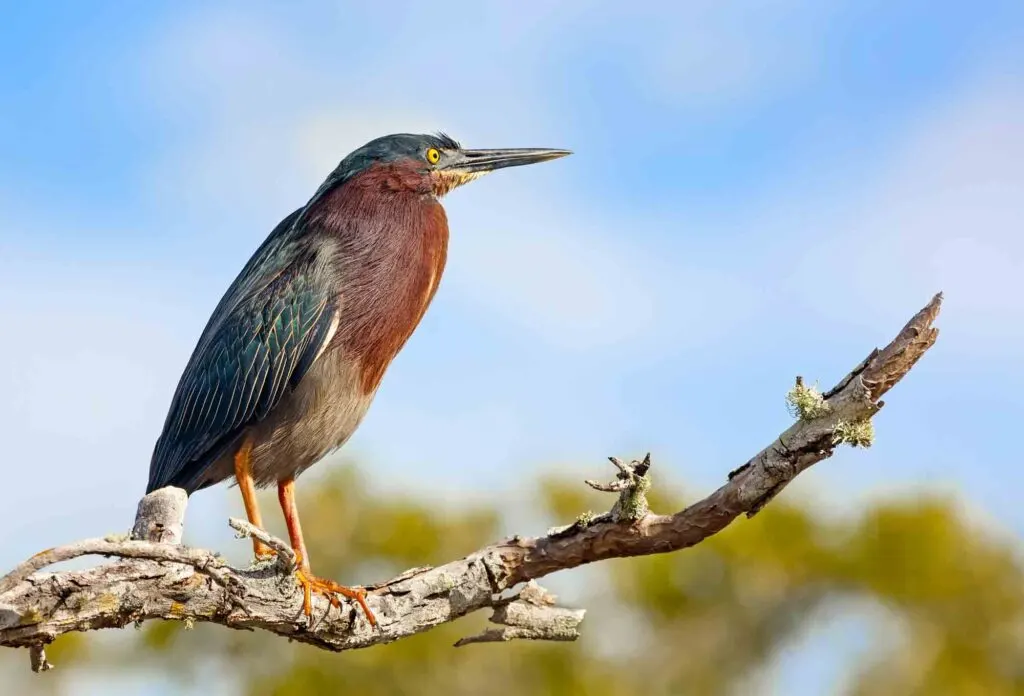
Green herons (Butorides virescens) are small, stocky birds native to both North America and Central America.
They measure between 16.1 and 18.1 inches and weigh only 8.5 ounces. The coloration of green herons is quite splendid: their backs are velvet-green, their bodies chestnut, and their heads and crests dark.
In addition, green herons have short necks and yellow legs, eyes, and bills.
Their diet consists mainly of small fish but includes frogs, reptiles, crustaceans, bugs, and small rodents.
Green herons are one of the few bird species that use tools for hunting; they create fishing lures using insects, bread crusts, and feathers. They will drop the lure on the water’s surface to attract a fish and strike at it.
Another interesting feature of green herons is that they hunt by wading for shallow-water prey and dive for deep-water prey.
In addition, they have webs between their middle and outer toes, allowing them to swim back to shore.
6. Great Blue Heron
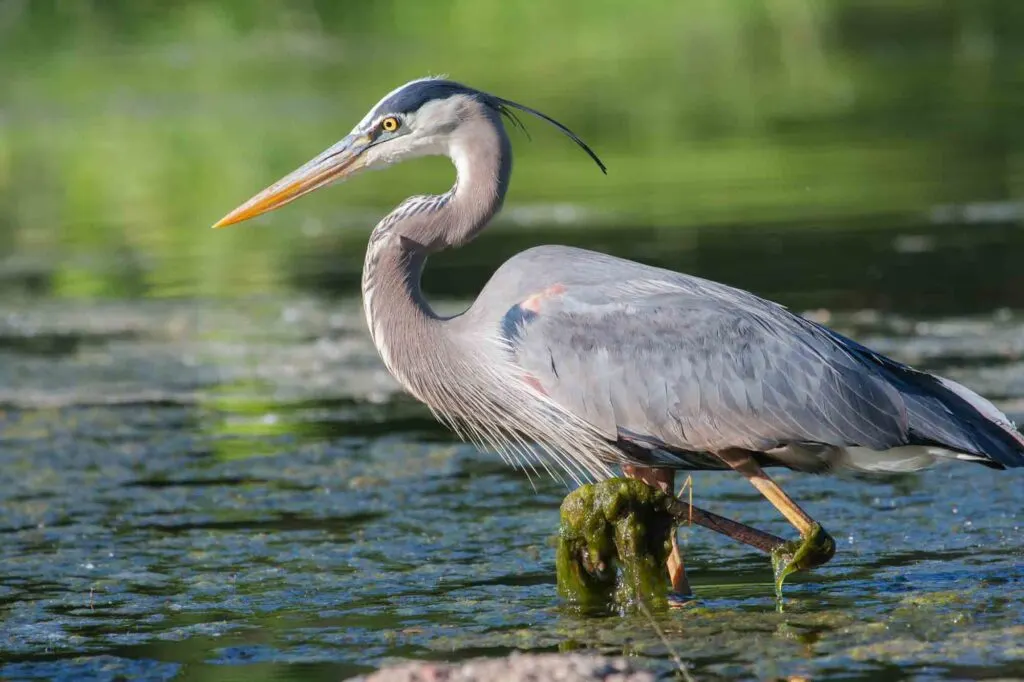
The great blue heron, or Ardea herodias, is a stately bird with light blue-gray plumage.
These tall waders have orange to yellow bills and a black crown with black plumage when they are adults.
Despite their large size, great blue herons weigh only five to six pounds because they have hollow bones, like all birds.
Great blue herons enjoy a diet of fish. They can be seen stalking along shorelines and in marshlands, estuaries, and ponds around much of the United States.
They also feed in open fields and on farmlands and congregate in large groups called “heronries” close to developed areas. These species of heron build their bulky stick nests in high trees.
An interesting feature of these American herons is that they can hunt during the day or night. Their night vision is improved because of the high percentage of rod-type photoreceptors in their eyes.
7. Goliath Heron
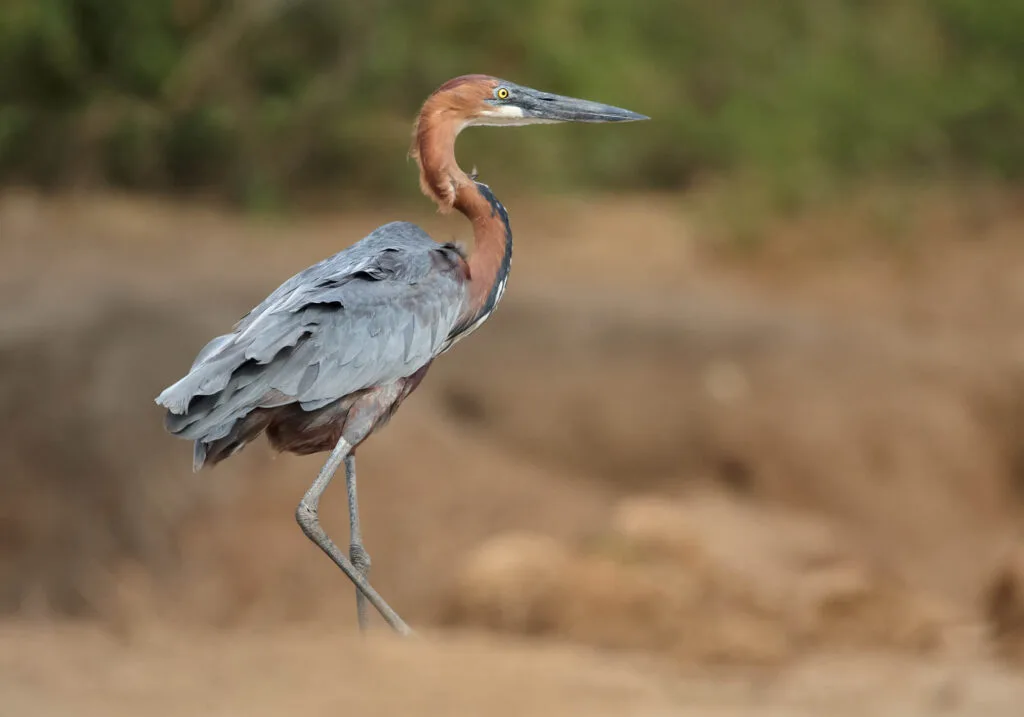
As their name suggests, goliath herons (Ardea goliath) are enormous; in fact, they are the largest of all heron types.
They stand almost five feet tall and weigh up to 11 pounds when mature. Goliath herons have a chestnut-colored head, crest, and neck, with some white feathers at the front of the neck. Their wings are slate gray in color.
Goliath herons are solitary birds and can be found in parts of Asia and in sub-Saharan Africa.
They inhabit marshlands, large rivers, mangroves, and estuaries and avoid being near developed areas. They make a distinctive “kowoork” barking call that can be heard farther than a mile away.
When it comes to catching prey, goliath herons have strong, dagger-like bills, which they use to impale their prey of large fish (up to 2 lbs.) and small animals.
Because they eat slowly, goliath herons are vulnerable to kleptoparasitism, whereas other birds steal the fish they have caught.
8. Purple Heron

The purple heron (Ardea purpurea) is a medium-sized wading bird measuring between 30 and 35 inches in length.
They weigh between one and three pounds and are characterized by their purple-brown plumage, black crown, crest, and belly.
Purple herons have long, pointed bills that are longer than in other types of herons. Their bill and legs are orange-yellow, and their eyes are pale yellow.
Purple herons breed in tropical to mid-temperate countries in Europe, Africa, and Southern Asia.
The European purple herons migrate to tropical Africa during the winter. These solitary birds feed in shallow, fresh water from nighttime to early morning and roost in coastal areas such as estuaries and mangroves. Their diet consists of fish and frogs.
During the breeding season, the purple herons’ plumage brightens, and they get more pendulous feathers on their breasts.
During courtship rituals, both males and females point their bills upwards with straight heads and necks, and their neck feathers fluff out.
9. Black Heron
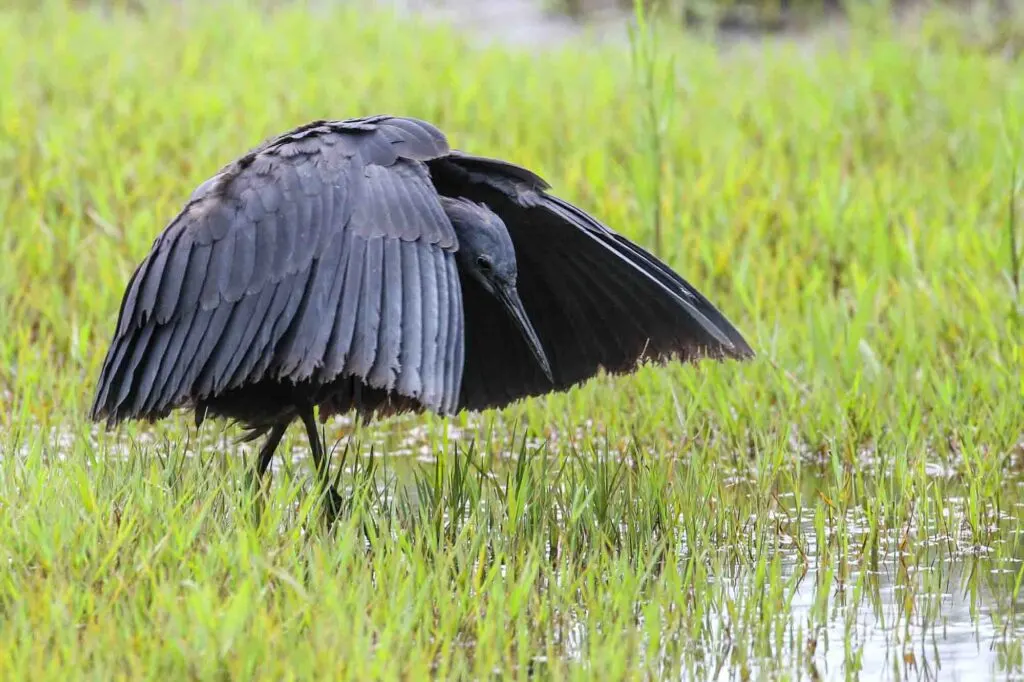
The black heron is an African heron that is sometimes called a black egret (Egretta ardesiaca).
They are predominantly found in the eastern half of Madagascar but have also been spotted in Greece and Italy.
These smallish birds weigh less than one pound and are easily recognizable by their entirely black plumage and yellow feet.
They prefer to hunt along the edges of freshwater lakes and ponds but can be found along river edges and marshes.
Black herons living along the coast may be seen feeding in alkaline lakes, tidal flats, and tidal rivers.
Black herons are one of the heron types that use a hunting method called “canopy feeding” to attract their prey.
They use their wings to create an umbrella that casts a shadow on the water. Small fish are then attracted to the shade, allowing the black heron to strike at a closer range.
They also eat crustaceans, amphibians, and aquatic insects.
10. Black-Crowned Night Heron
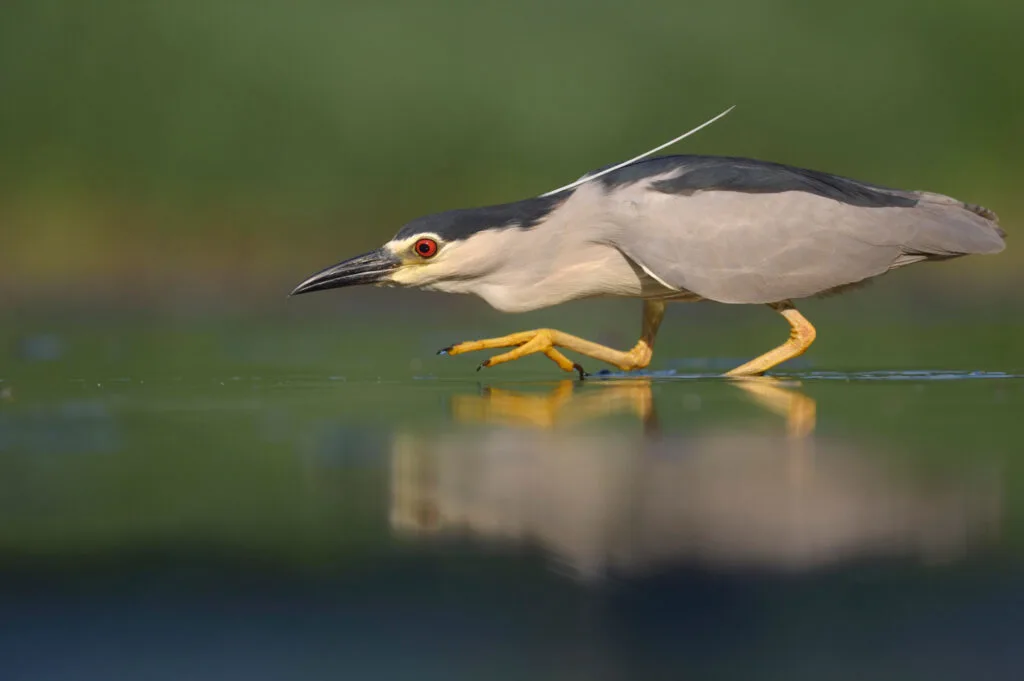
The black-crowned night heron (Nycticorax nycticorax) is a medium-sized, stocky heron that is about 22.8 to 26 inches long and weighs between 1.5 and 2.2 pounds.
It is predominantly white or light gray with a black crown and intense red eyes.
Black-crowned night herons are the most common heron species in the world, with a wide range. They breed on every continent except Antarctica and Australia.
In North America, black-crown night herons are more populated along the coast. Those in the U.S. tend to migrate southward at nighttime along the coast or Mississippi River system during September and October.
Black-crowned night herons feed at night to the early morning hours. Since they are opportunistic feeders, they have a diverse diet, including fish, worms, insects, leeches, crustaceans, small reptiles, birds, rodents, eggs, and even garbage at dumpsites.
They tend to nest in large colonies, seeking dense bushes for protection and a body of water close by for foraging.
11. Yellow-Crowned Night Heron

The yellow-crowned night heron (Nyctanassa violacea) is the only other night heron found in the United States.
Despite it being a night heron, these beautiful birds will also eat during the day. They are more solitary than black-crowned night herons. Yellow-crowned night herons are found in North, Central, and South America, specifically along the eastern coastlines.
The habitats of these species of herons include mangroves, barrier beaches, rocky coasts, and tidal mudflats.
However, they can be spotted in inland swamps, lagoons, rivers, lakes, and marshes. Yellow-crowned night herons enjoy a diet consisting mainly of crustaceans. Still, they will eat fish, snails, aquatic insects, and snakes too.
Regarding their physical characteristics, yellow-crowned night herons are medium-sized, graceful birds that weigh about 1.5 pounds.
Their coloration is blue-gray, with black heads and a white crown. Adults develop a yellow burst of feathers at the front of their crowns. During the breeding season, they grow long plumes, and their eyes and legs turn scarlet.
12. Boat-Billed Heron
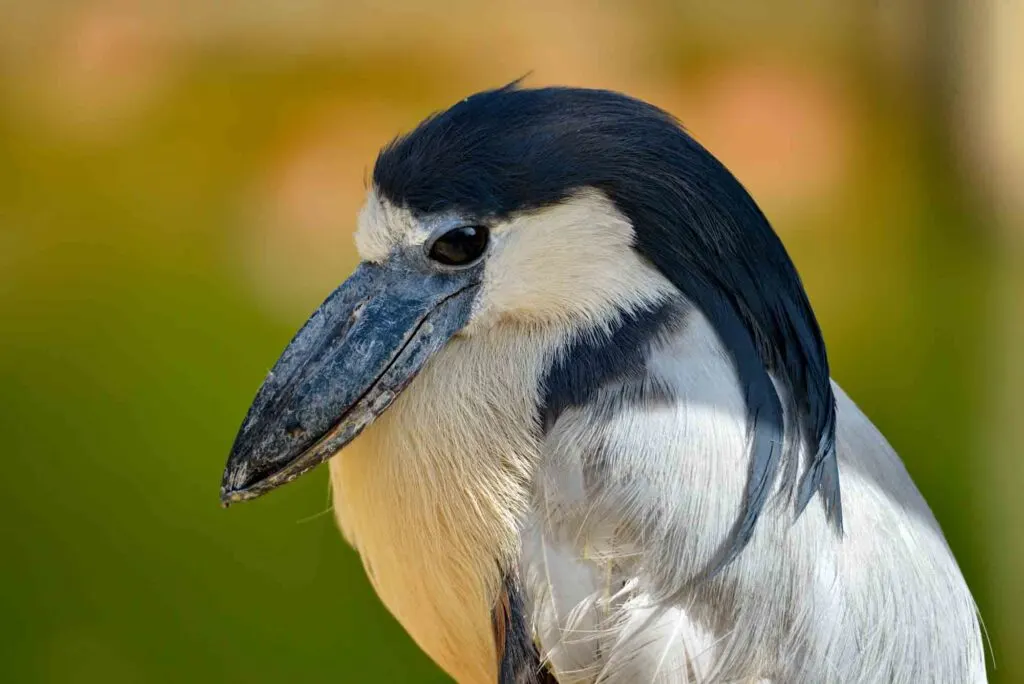
The boat-billed heron (Cochlearius cochlearius) is considered bizarre-looking for a heron because of its large brown eyes and impressive boat-shaped bill.
Adult boatbills are gray to white in color and have chestnut-colored abdomens. Their large bill and flanks are black, and they have a crest that they show off during the mating season. They weigh, on average, 1.5 pounds.
These nocturnal, non-migratory herons are distributed in the northern parts of South America.
They are semi-colonial birds that make twig nests in mangrove trees. Boatbills tend to forage in freshwater, vegetative streams, and the shallower parts of lagoons.
Their diet consists of crustaceans, small mammals, some fish, frogs, mollusks, and insects.
Boat-billed herons do not hunt with a source of light, whether from the moon, sun, or artificial.
They also do not enjoy human interference and will abandon their nests if disturbed, leading to decreased reproductive success.
13. White-Crested Tiger Heron
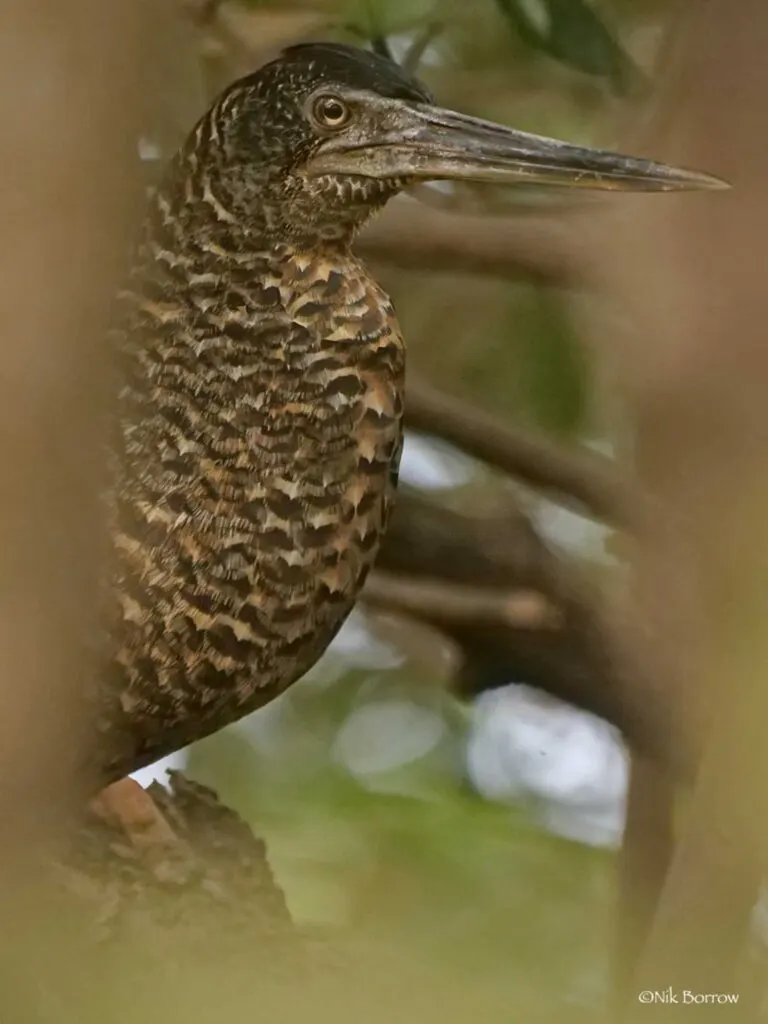
The white-crested tiger heron (Tigriornis leucolopha) is also known as the white-crested bittern.
These medium-sized birds weigh about 2.25 pounds and are cryptically colored. The bodies of white-crested tiger herons are barred with black and buff, and they have black heads with a white crest that is visible only when erect.
White-crested tiger herons are widely distributed in the equatorial rainforests of Africa and are not under threat. They are not known to be migratory birds and are very seldom seen or studied.
When a single, flimsy nest of twigs was observed in a tree, the observer faced a hissing, solitary parent with its tail and primary feathers spread out.
White-crested tiger herons can be found along small streams, marshes, and swamps in rainforests.
While their diet isn’t detailed, it is believed these birds are nocturnal, eating small fish, frogs, crabs, snakes, and insects.
14. Snowy Egret
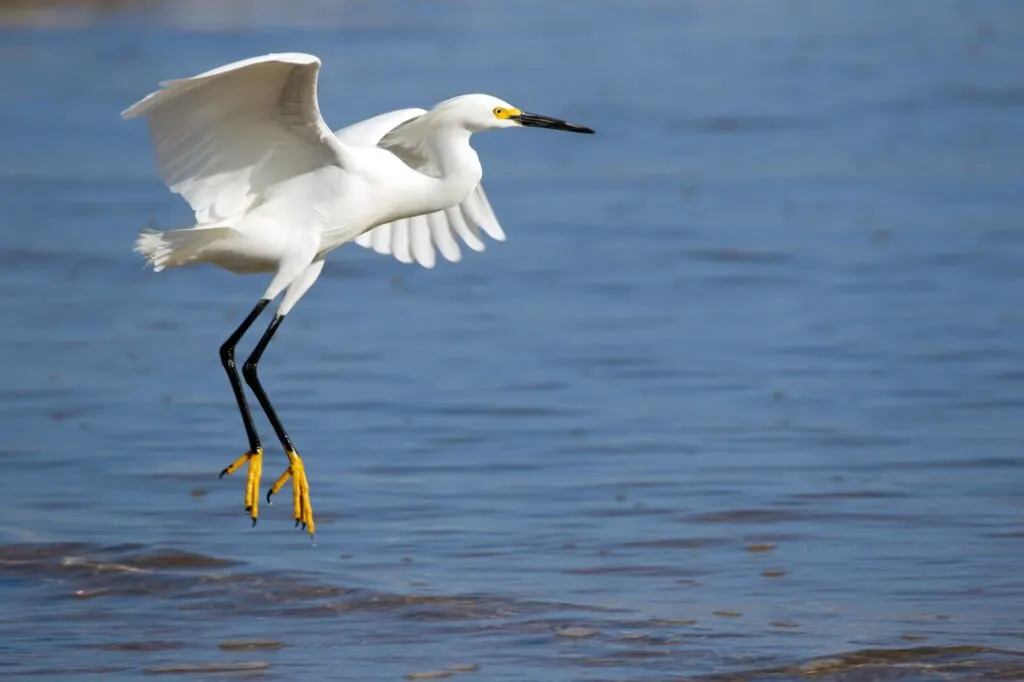
The snowy egret (Egretta thula) is a small, white heron that is graceful in appearance–a bit bigger than the cattle egret.
These herons are all-white, except for a black bill and legs and yellow feet.
Additionally, they have a yellow band at the base of their bill that extends to their eyes. They measure between 22 to 26 inches and weigh about 13.1 ounces.
They are found in the non-mountainous areas of South America and the southern parts of the United States.
Most snowy egrets are residents, meaning they do not migrate. However, those in central North America tend to migrate to warmer areas during winter.
Snowy egrets are commonly seen in shallow wetland areas and forage on small fish, crustaceans, insects, and small reptiles.
They breed in mixed colonies and are no longer under threat. At one stage, their numbers were dangerously low as they were hunted for their elegant plumes that were popular in the fashion industry. In 1886, their plumes were worth double the price of gold.
15. Zigzag Heron
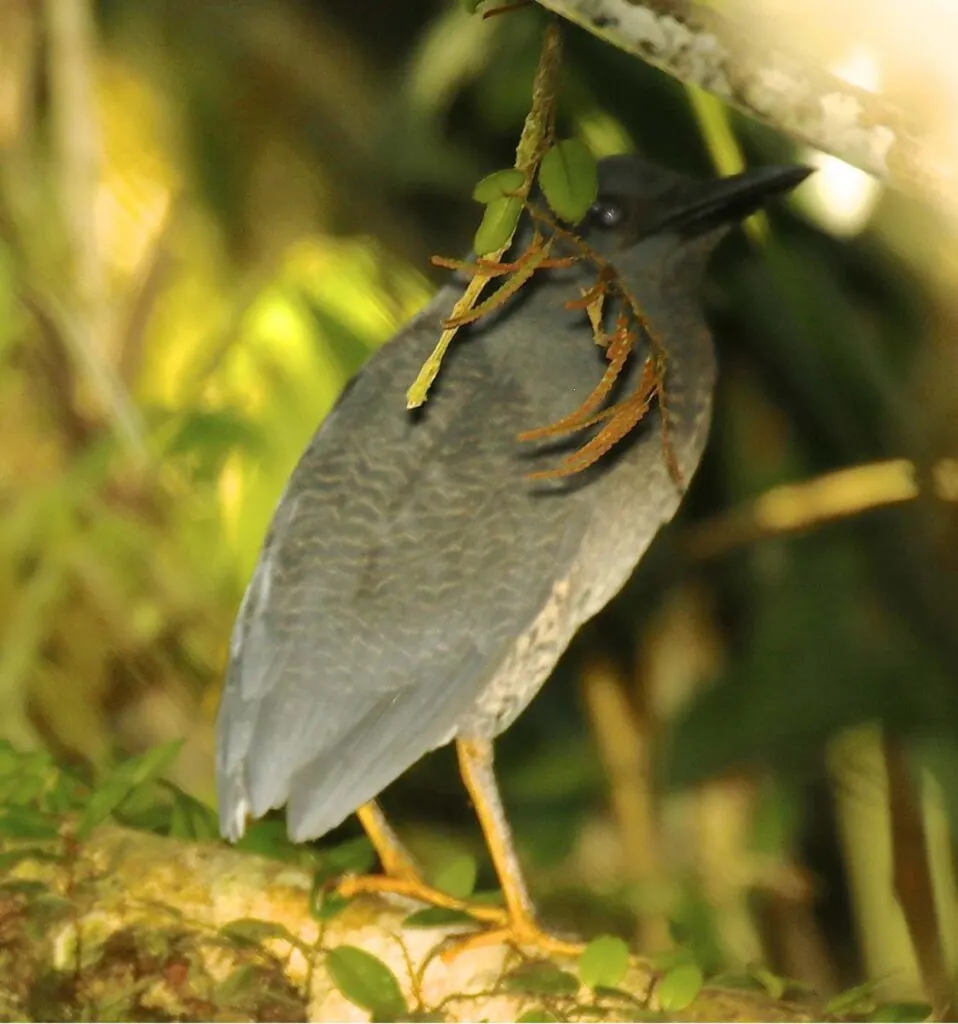
The zigzag heron (Zebrilus undulatus) is a reclusive bird measuring about twelve inches and weighing four ounces.
They are considered bitterns because they have ten (albeit short) tail feathers instead of twelve.
The zigzag heron is found in the northern parts of South America in dense forests and is on the border of being threatened. Zigzag herons are not migratory birds.
Zigzag herons have a dark vermiculated coloration. Their upper bodies are gray with fine barring, while their underparts are lighter and have a gray crest.
They perch on low branches overhanging swamps and marshes when hunting. The zigzag heron’s diet consists mainly of fish and insects. When it sees a fish, the zigzag heron’s tail starts to bob up and down.
Zigzag herons forage in shallow water and on land. They walk slowly and hop when they catch flying insects.
They tend to feed and dawn and at dusk, resting and preening themselves throughout the day.
16. American Bittern
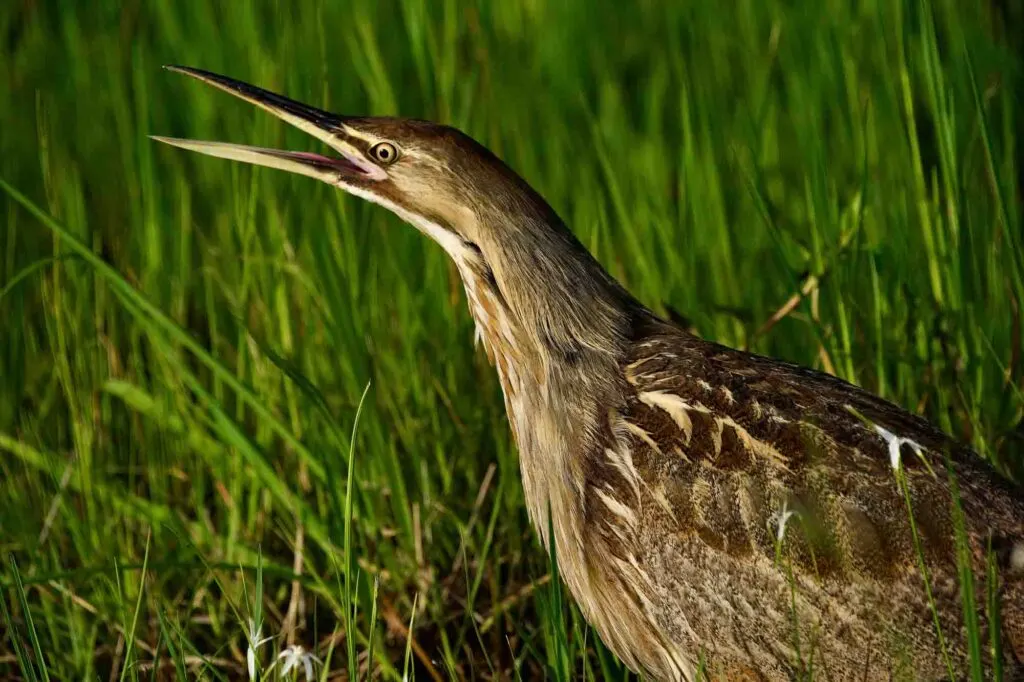
The American bittern (Botaurus lentiginosus) is a solitary wading bird that forages in freshwater marshes.
It is medium to large in size and is stoutly built. The coloration of the American bittern includes warm brown, buff, and white feathers.
Their necks are strongly streaked, camouflaging them well when walking through reeds. They weigh between 13.1 and 17.6 ounces.
American bitterns breed in Canada and the north and central parts of the United States.
They migrate to the U.S. Gulf Coasts, Florida, and the Caribbean for the winter. They are stealthy predators, standing still enough to be undetected by prey approaching them.
If they stalk their prey, they do so almost imperceptibly.
The diet of American bitterns consists of fish, eels, frogs, aquatic insects, crustaceans, salamanders, and garter snakes.
Male American bitterns have an incredible call that involves clicking their bill and making a sound similar to blowing air into bottles.
17. Great Egret
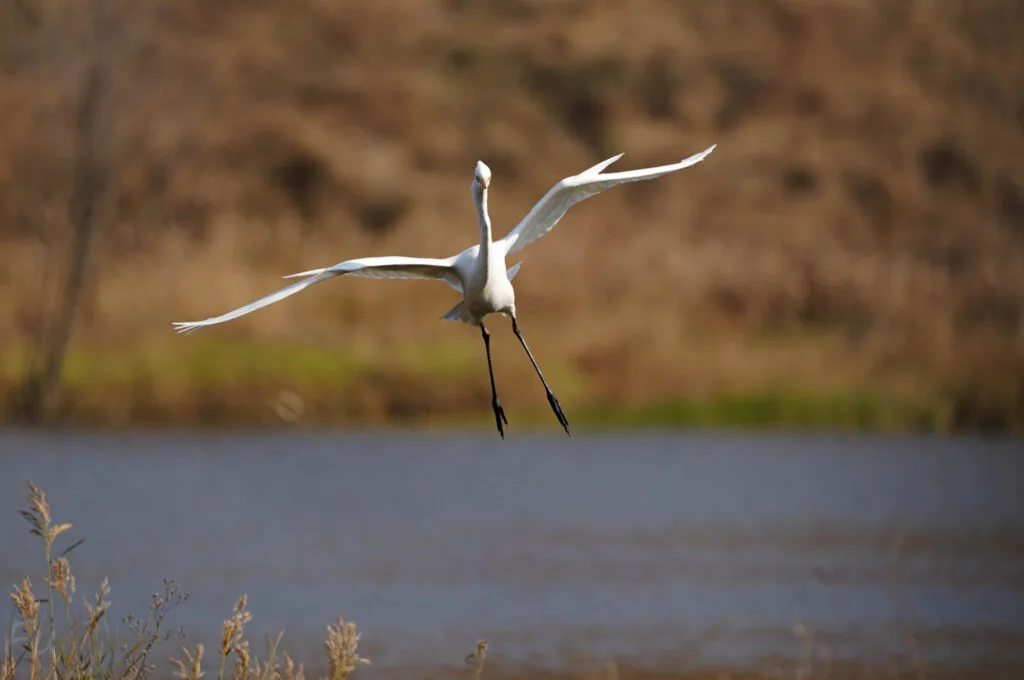
The great egret (Ardea alba) is also referred to as the great white heron because of its size.
These elegant birds stand up to 3.3 feet tall, and their body mass averages 2.2 pounds.
Great egrets have all-white plumage, a yellow bill, and black legs and feet. Their plumes, like snowy egrets, were highly sought after, leading to their numbers in the United States being decimated in the late 1800s.
Thankfully, their numbers have increased since conservation efforts protected them from being hunted.
Great egrets are distributed in the Americas, Africa, Europe, and Asia. Those that live in temperate climates do not migrate; however, those in colder areas in North America and Europe do.
Great egrets forage primarily in shallow waters but occasionally hunt in open fields. They are communal birds, often foraging with other types of herons and ibises.
Their diet consists mainly of fish, crustaceans, salamanders, snakes, and aquatic insects. If hunting in open fields, they eat grasshoppers, rodents, snails, and small animals.
18. Tricolored Heron
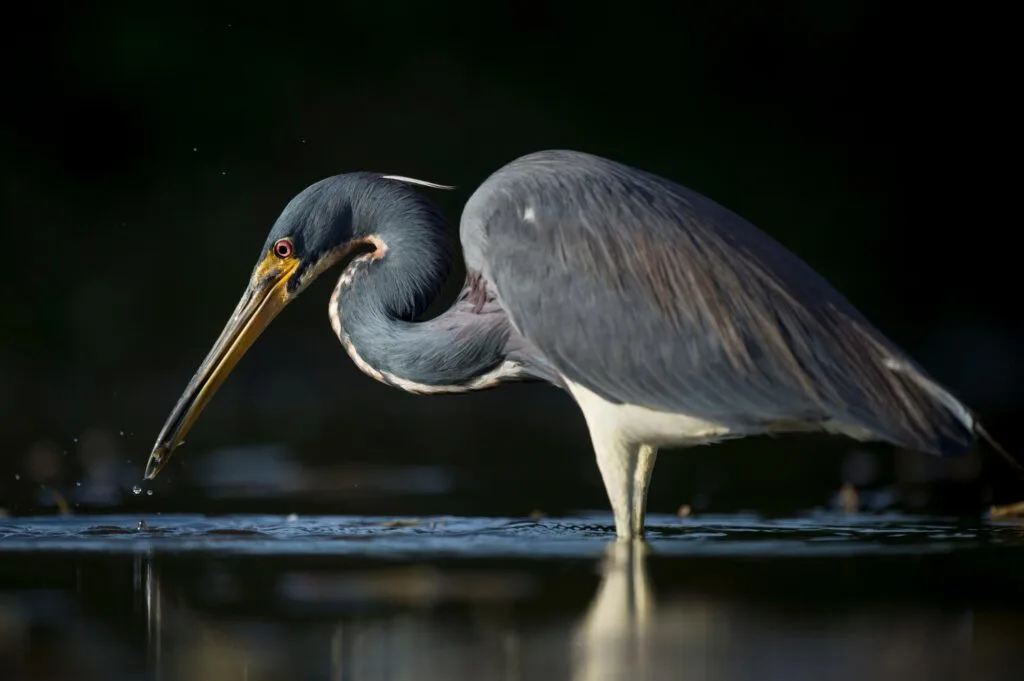
The tricolored heron (Egretta tricolor) used to be called the Louisiana heron and is native to the coastal parts of the Americas.
It is a distinctive, sleek wading bird with lavender, blue-gray, and white coloration. They have white bellies and a white stripe down their necks. These herons reach 27.6 inches and weigh, on average, 14.6 ounces.
Tricolored herons tend to forage alone but nest communally. They can be found feeding in salt marshes, coastal estuaries, lagoons, and mangroves with dense vegetation during the breeding season.
When it is not breeding season, they use freshwater lake edges, wetlands, and canals for hunting.
Their diet consists mainly of small fish. However, tricolor herons use their dagger-like bills to catch crustaceans, salamanders, insects, frogs, lizards, and spiders.
They will sometimes wade belly-deep in water and aggressively defend their feeding territory by driving other birds away, even different types of herons.
Hey you! Did you like this article about the different types of herons? Then share it with your friends on social media!
Summary of 18 Interesting Types of Herons
1. Gray Heron
2. Western Reef Heron
3. Reddish Egret
4. Whistling Heron
5. Green Heron
6. Great Blue Heron
7. Goliath Heron
8. Purple Heron
9. Black Heron
10. Black-Crowned Night Heron
11. Yellow-Crowned Night Heron
12. Boat-Billed Heron
13. White-Crested Tiger Heron
14. Snowy Egret
15. Zigzag Heron
16. American Bittern
17. Great Egret
18. Tricolored Heron
